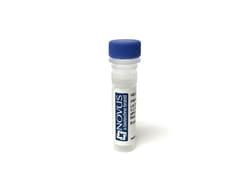Arginase 1/ARG1/liver Arginase Antibody (ARG1/1126) - Azide and BSA Free, Novus Biologicals™
Mouse Monoclonal Antibody
Manufacturer: Fischer Scientific
The price for this product is unavailable. Please request a quote
Antigen
Arginase 1/ARG1/liver Arginase
Concentration
1.0 mg/mL
Applications
Flow Cytometry, Immunohistochemistry (Paraffin), Immunofluorescence, CyTOF
Conjugate
Unconjugated
Host Species
Mouse
Research Discipline
Cancer, Cellular Markers, Chromatin Research, Lipid and Metabolism, Myeloid derived Suppressor Cell
Formulation
PBS with No Preservative
Gene ID (Entrez)
383
Immunogen
Recombinant fragment (87 Amino acid residues around aa 1-150) of human ARG1 protein
Primary or Secondary
Primary
Content And Storage
Store at 4C short term. Aliquot and store at -20C long term. Avoid freeze-thaw cycles.
Molecular Weight of Antigen
36.5 kDa
Clone
ARG1/1126
Dilution
Flow Cytometry : 0.5 - 1 ug/million cells in 0.1 ml, Immunohistochemistry-Paraffin : 2 - 4 ug/ml, Immunofluorescence : 1 - 2 ug/ml, CyTOF-ready
Classification
Monoclonal
Form
Purified
Regulatory Status
RUO
Target Species
Human
Gene Alias
arginase 1, arginase, liver, arginase-1, EC 3.5.3.1, Liver-type arginase, Type I arginase
Gene Symbols
ARG1
Isotype
IgG3 κ
Purification Method
Protein A or G purified
Test Specificity
Recognizes a protein of 35-38kDa, which is identified as Arginase 1 (ARG1). Arginase is a manganese metallo-enzyme that catalyzes the hydrolysis of arginine to generate ornithine and urea. Arginase I and II are isoenzymes, which differ in subcellular localization, regulation, and possibly function. Arginase I is a cytosolic enzyme, which is expressed mainly in the liver as part of the urea cycle, whereas arginase II is a mitochondrial protein found in a variety of tissues. Antibody to ARG-1 labels hepatocytes in normal tissues and granulocytes in peripheral blood. ARG-1 is a sensitive and specific marker for identification of hepatocellular carcinoma.
Description
- Arginase 1/ARG1/liver Arginase Monoclonal specifically detects Arginase 1/ARG1/liver Arginase in Human samples
- It is validated for Immunohistochemistry, Immunohistochemistry-Paraffin, Protein Array.
